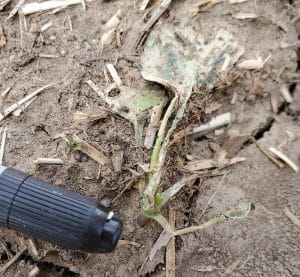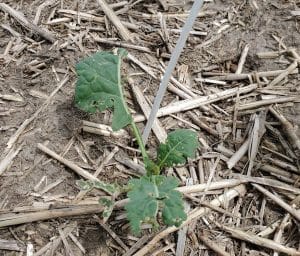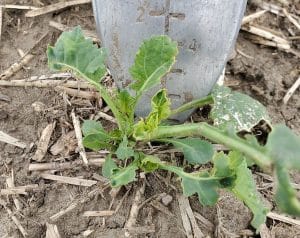Early season hail rarely has an impact on canola yield potential because hailed seedlings usually survive. Delayed maturity as a result of hail damage is probably more of a concern than the loss of yield potential.
Even when a field looks to be completely wiped out, some seedlings will survive and re-grow from the growing point. If hail damages the growing point beyond recovery or snaps the stem, these plants usually do not survive.
A 2020 case study from Alberta
Some Prairie fields (especially around Calgary) were flattened by a couple of massive heavy hailstorms in mid June of 2020. Even in severe cases where many individual plants may die, a whole canola crop is fairly resilient to early season hail when it comes to overall yield potential…as long as a few plants survive per square foot.

Walk the field after the hail storm. Identify the best and worst areas of the field, and flag some individual plants and make a guess on survival. Pin flags with a Y (will survive) or N (won’t survive) and then return in a few days to see if you’re right. In the meantime, get a hail insurance assessment.
When you do return to the field, note recovery and average plant densities across the field and in patches. Are the bad patches bad enough to justify a re-seed or did a somewhat uniform stand of two or more plants per square foot survive? Are there any problem weeds that you will lose control of before the canola gets to canopy closure? Reseeding will be higher risk at this calendar date, even though major hail damage will likely delay maturity.
…Ten days later
Ten days after the hailstorms of southern Alberta, the local Canola Council agronomy specialist returned to the same fields to check on her marked plants. She observed that most plants killed in the hail were gone 10 days later. (They dried up.) The remaining seedlings were defoliated but had with intact growing points, so survived. Ten days after the hail, the plant stand ranged from 10 to 50 plants per square metre (one to five per square foot). Weeds are coming and will be a challenge in some areas, but re-seeding likely wouldn’t have been economical.
Rescue treatments for hail
There is no evidence that foliar nutrition or fungicides will help the crop heal. However, we do know that crops damaged early in the season are susceptible to increased blackleg infections. Fungicide might help, but use it only if you were considering using it in the first place. If the field was already at high risk of blackleg, hail damage increases that risk. If blackleg was not a major risk, a fungicide application probably won’t help much or you won’t see a return on investment. Blackleg lesions (small, beige lesions with black pycnidia) on leaves or pseudothecia/ pycnidia on canola residue are indicators of risk. If the variety is overcome by the blackleg races present, then the risk of yield loss is elevated. More on fungicide for blackleg.
A top dress of nitrogen fertilizer may compensate for nitrogen lost through hail-shredded leaves, but keep in mind that the yield potential of the crop is also lower — so the question is how much more do you want to invest in this crop? If you were planning to top dress prior to the storm, then continue with that plan. Adequate nutrient availability still might be your most limiting factor to yield, especially if the soil moisture is improved following the storm.
Leave check strips. When applying a rescue treatment, leave multiple check strips and compare yields for treated and untreated strips. Multiple strips are important in this case given the spotty nature of hail. Using one strip or applying treatment to half the field may not provide an accurate comparison.


